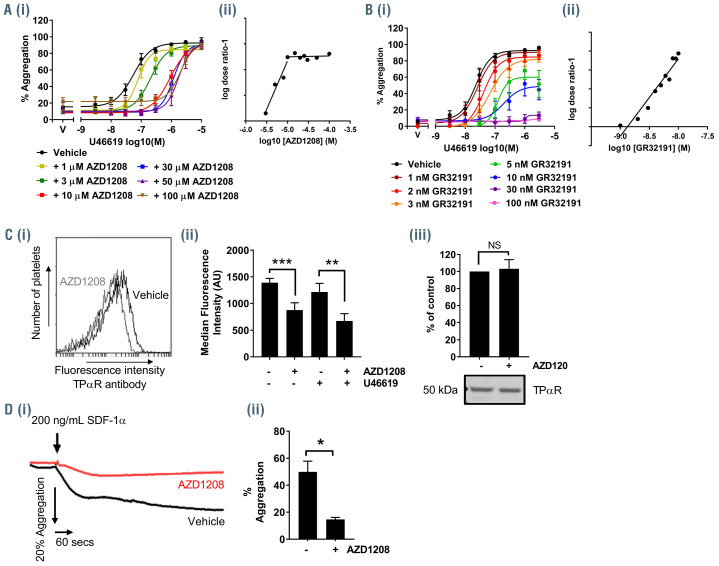Figure 6.
AZD1208 reduces TPαR surface expression and signaling and does not act as a competitive antagonist of the TPαR. (A, B) Human washed platelets were pre-treated with: (A) AZD1208 (1, 3, 10, 30, 50 and 100 μM) or (B) GR32191 (1, 2, 3, 5, 10, 30, 100 nM) prior to stimulation with U46619 (3 nM–3 μM) and aggregation was monitored after 5 min using an optical light transmission plate-based aggregometry assay. Quantified data are shown. (i) Percentage aggregation. (ii) EC50 values from the aggregation dose-response curves determined following incubation with AZD1208 were used to plot a Schild regression plot to determine whether AZD1208 acts as an antagonist for the TxA2 receptor. (C) Platelets were treated with AZD1208 (10 μM; 10 mins) or vehicle control. Surface expression of TPαR was assessed using an antibody that recognizes the extracellular portion of the TPαR and detected by flow cytometry. Samples were diluted in HBS and not fixed to avoid disruption of the membrane. Anti-DOK6 antibody was included as a negative control. (i) A representative histogram from the flow cytometer. (ii) Data are expressed as median fluorescent intensity (MFI). (iii) Total cellular TPαR was detected by western blotting. (D) Human platelet-rich plasma was pretreated with AZD1208 (100 μM) or vehicle, as a control, for 10 min prior to stimulation with SDF-1α(200 ng/mL) and aggregation was monitored using optical light transmission aggregometry for 5 min. (i) Representative trace and (ii) quantified data are shown. Results are mean + standard error of mean for n≥3, *P≤0.05, **P≤0.01, ***P≤0.005 in comparison to vehicle-treated control; where normalized data are shown, statistics were performed prior to normalization.

